In-Situ Synchrotron X-ray Study on the Structure Variation of Morphology-Identified Injection-Molded β-Nucleated iPP under Tensile Deformation
Abstract
:1. Introduction
2. Materials and Methods
2.1. Materials and Sample Preparation
2.2. X-ray Measurements
2.3. Morphological Scan Measurement
2.4. Tensile Deformation Measurement
2.5. Data Evaluation for X-ray Scattering
2.5.1. Overall Crystallinity Index and Individual Crystallinity Index
2.5.2. Crystal Size
2.5.3. Long Period
2.5.4. Orientation Degree
3. Results and Discussion
3.1. Morphological Distributions
3.2. Structure Variation under Tensile Deformation
4. Conclusions
Author Contributions
Funding
Institutional Review Board Statement
Informed Consent Statement
Data Availability Statement
Acknowledgments
Conflicts of Interest
References
- Phillips, A.; Zhu, P.-W.; Edward, G. Polystyrene as a versatile nucleating agent for polypropylene. Polymer 2010, 51, 1599–1607. [Google Scholar] [CrossRef]
- De Rosa, C.; Auriemma, F.; Paolillo, M.; Resconi, L.; Camurati, I. Crystallization Behavior and Mechanical Properties of Regiodefective, Highly Stereoregular Isotactic Polypropylene: Effect of Regiodefects versus Stereodefects and Influence of the Molecular Mass. Macromolecules 2005, 38, 9143–9154. [Google Scholar] [CrossRef]
- Housmans, J.-W.; Gahleitner, M.; Peters, G.W.M.; Meijer, H.E.H. Structure-property relations in molded, nucleated isotactic polypropylene. Polymer 2009, 50, 2304–2319. [Google Scholar] [CrossRef]
- Meille, S.V.; Bruckner, S.; Porzio, W. γ-Isotactic polypropylene. A structure with nonparallel chain axes. Macromolecules 1990, 23, 4114–4121. [Google Scholar] [CrossRef]
- Krache, R.; Benavente, R.; López-Majada, J.M.; Pereña, J.M.; Cerrada, M.L.; Pérez, E. Competition between α, β, and γ Polymorphs in a β-Nucleated Metallocenic Isotactic. Polypropyl. Macromol. 2007, 40, 6871–6878. [Google Scholar] [CrossRef] [Green Version]
- Varga, J. β-Modification of isotactic polypropylene: Preparation, structure, processing, properties, and application. J. Macromol. Sci. Part B 2002, 41, 1121–1171. [Google Scholar] [CrossRef]
- Karger-kocsis, J.; Varga, J. Effects of β-α transformation on the static and dynamic tensile behavior of isotactic polypropylene. J. Appl. Polym. Sci. 1996, 62, 291–300. [Google Scholar] [CrossRef]
- Romero-Diez, S.; Kweon, M.S.; Kim, E.S.; Gupta, A.; Yan, X.J.; Pehlert, G.; Park, C.B.; Lee, P.C. In situ visualization of crystal nucleation and growth behaviors of linear and long chain branched polypropylene under shear and CO2 pressure. Polymer 2021, 213, 123215. [Google Scholar] [CrossRef]
- Nazari, B.; Tran, H.; Beauregard, B.; Flynn-Hepford, M.; Harrel, D.; Milner, S.T.; Colby, R.H. Two Distinct Morphologies for Semicrystalline Isotactic Polypropylene Crystallized after Shear Flow. Macromolecules 2018, 51, 4750–4761. [Google Scholar] [CrossRef]
- Liparoti, S.; Speranza, V.; Sorrentino, A.; Titomanlio, G. Mechanical Properties Distribution within Polypropylene Injection Molded Samples: Effect of Mold Temperature under Uneven Thermal Conditions. Polymers 2017, 9, 585. [Google Scholar] [CrossRef] [Green Version]
- Hamad, F.G.; Colby, R.H.; Milner, S.T. Transition in Crystal Morphology for Flow-Induced Crystallization of Isotactic Polypropylene. Macromolecules 2016, 49, 5561–5575. [Google Scholar] [CrossRef]
- De Santis, F.; Pantani, R.; Titomanlio, G. Effect of shear flow on spherulitic growth and nucleation rates of polypropylene. Polymer 2016, 90, 102–110. [Google Scholar] [CrossRef]
- Kalay, G.; Bevis, M.J. Processing and physical property relationships in injection-molded isotactic polypropylene. 2. Morphology and crystallinity. J. Polym. Sci. Part B Polym. Phys. 1997, 35, 265–291. [Google Scholar] [CrossRef]
- Zhong, G.-J.; Li, Z.-M. Injection molding-induced morphology of thermoplastic polymer blends. Polym. Eng. Sci. 2005, 45, 1655–1665. [Google Scholar] [CrossRef]
- Huo, H.; Jiang, S.; An, L.; Feng, J. Influence of Shear on Crystallization Behavior of the β Phase in Isotactic Polypropylene with β-Nucleating Agent. Macromolecules 2004, 37, 2478–2483. [Google Scholar] [CrossRef]
- Chen, Y.H.; Mao, Y.M.; Li, Z.M.; Hsiao, B.S. Competitive Growth of alpha- and beta-Crystals in beta-Nucleated Isotactic Polypropylene under Shear Flow. Macromolecules 2010, 43, 6760–6771. [Google Scholar] [CrossRef]
- Chen, J.; Schneider, K.; Kretzschmar, B.; Heinrich, G. Nucleation and growth behavior of β-nucleated iPP during shear induced crystallization investigated by in-situ synchrotron WAXS and SAXS. Polymer 2014, 55, 5477–5487. [Google Scholar] [CrossRef]
- Chen, J.; Schneider, K.; Gao, S.; Vogel, R.; Heinrich, G. In-situ synchrotron X-ray studies of crystallization of β-nucleated iPP subjected to a wide range of shear rates and shear temperatures. Polymer 2015, 76, 182–190. [Google Scholar] [CrossRef]
- Zhu, P.-W.; Tung, J.; Phillips, A.; Edward, G. Morphological Development of Oriented Isotactic Polypropylene in the Presence of a Nucleating Agent. Macromolecules 2006, 39, 1821–1831. [Google Scholar] [CrossRef]
- Samon, J.M.; Schultz, J.M.; Hsiao, B.S. Study of the cold drawing of nylon 6 fiber by in-situ simultaneous small- and wide-angle X-ray scattering techniques. Polymer 2000, 41, 2169–2182. [Google Scholar] [CrossRef]
- Stoclet, G.; Seguela, R.; Lefebvre, J.M.; Rochas, C. New Insights on the Strain-Induced Mesophase of Poly(d,l-lactide): In Situ WAXS and DSC Study of the Thermo-Mechanical Stability. Macromolecules 2010, 43, 7228–7237. [Google Scholar] [CrossRef]
- Zhang, X.; Schneider, K.; Liu, G.; Chen, J.; Brüning, K.; Wang, D.; Stamm, M. Structure variation of tensile-deformed amorphous poly(l-lactic acid): Effects of deformation rate and strain. Polymer 2011, 52, 4141–4149. [Google Scholar] [CrossRef]
- Zhang, X.; Schneider, K.; Liu, G.; Chen, J.; Brüning, K.; Wang, D.; Stamm, M. Deformation-mediated superstructures and cavitation of poly(l-lactide): In-situ small-angle X-ray scattering study. Polymer 2012, 53, 648–656. [Google Scholar] [CrossRef]
- Schneider, K.; Trabelsi, S.; Zafeiropoulos, N.E.; Davies, R.; Riekel, C.; Stamm, M. The Study of Cavitation in HDPE Using Time Resolved Synchrotron X-ray Scattering During Tensile Deformation. Macromol. Symp. 2006, 236, 241–248. [Google Scholar] [CrossRef]
- Cai, J.; Hsiao, B.S.; Gross, R.A. Real-Time Structure Changes during Uniaxial Stretching of Poly(ω-pentadecalactone) by in Situ Synchrotron WAXD/SAXS Techniques. Macromolecules 2011, 44, 3874–3883. [Google Scholar] [CrossRef]
- Ran, S.; Zong, X.; Fang, D.; Hsiao, B.S.; Chu, B.; Phillips, R.A. Structural and Morphological Studies of Isotactic Polypropylene Fibers during Heat/Draw Deformation by in-Situ Synchrotron SAXS/WAXD. Macromolecules 2001, 34, 2569–2578. [Google Scholar] [CrossRef]
- Lin, Y.F.; Chen, W.; Meng, L.P.; Wang, D.L.; Li, L.B. Recent advances in post-stretching processing of polymer films with in situ synchrotron radiation X-ray scattering. Soft Matter 2020, 16, 3599–3612. [Google Scholar] [CrossRef] [PubMed]
- Lu, Y.; Chen, R.; Zhao, J.; Jiang, Z.Y.; Men, Y.F. Stretching Temperature Dependency of Fibrillation Process in Isotactic Polypropylene. J. Phys. Chem. B 2017, 121, 6969–6978. [Google Scholar] [CrossRef]
- Yang, F.; Yang, F.; Xiang, M.; Wu, T. Preparation of highly oriented β polypropylene and its pore formation mechanism during stretching. Polym. Cryst. 2021, 4, e10183. [Google Scholar]
- Chen, X.W.; Lv, F.; Lin, Y.F.; Wang, Z.; Meng, L.P.; Zhang, Q.L.; Zhang, W.W.; Li, L.B. Structure evolution of polyethylene-plasticizer film at industrially relevant conditions studied by in-situ X-ray scattering: The role of crystal stress. Eur. Polym. J. 2018, 101, 358–367. [Google Scholar] [CrossRef]
- Pawlak, A.; Galeski, A. Plastic Deformation of Crystalline Polymers: The Role of Cavitation and Crystal Plasticity. Macromolecules 2005, 38, 9688–9697. [Google Scholar] [CrossRef]
- Liu, G.; Zhang, X.; Liu, Y.; Li, X.; Chen, H.; Walton, K.; Marchand, G.; Wang, D. Effect of elastomer on crystalline transition and deformation behavior of isotactic polypropylene. Polymer 2013, 54, 1440–1447. [Google Scholar] [CrossRef]
- Lin, Y.F.; Li, X.Y.; Chen, X.W.; An, M.F.; Zhang, Q.L.; Wang, D.L.; Chen, W.; Yin, P.C.; Meng, L.P.; Li, L.B. Deformation mechanism of hard elastic polyethylene film during uniaxial stretching: Effect of stretching speed. Polymer 2019, 178, 121579. [Google Scholar] [CrossRef]
- Li, X.Y.; Lin, Y.F.; Ji, Y.X.; Meng, L.P.; Zhang, Q.L.; Zhang, R.; Zhang, W.H.; Li, L.B. Strain and temperature dependence of deformation mechanism of lamellar stacks in HDPE and its guidance on microporous membrane preparation. Polymer 2016, 105, 264–275. [Google Scholar] [CrossRef]
- Pawlak, A.; Galeski, A. Cavitation during Tensile Deformation of Polypropylene. Macromolecules 2008, 41, 2839–2851. [Google Scholar] [CrossRef]
- Van der Beek, M.H.E.; Peters, G.W.M.; Meijer, H.E.H. Influence of Shear Flow on the Specific Volume and the Crystalline Morphology of Isotactic Polypropylene. Macromolecules 2006, 39, 1805–1814. [Google Scholar] [CrossRef]
- Varga, J.; Menyhárd, A. Effect of Solubility and Nucleating Duality of N,N′-Dicyclohexyl-2,6-naphthalenedicarboxamide on the Supermolecular Structure of Isotactic Polypropylene. Macromolecules 2007, 40, 2422–2431. [Google Scholar] [CrossRef]
- Yamaguchi, M.; Fukui, T.; Okamoto, K.; Sasaki, S.; Uchiyama, Y.; Ueoka, C. Anomalous molecular orientation of isotactic polypropylene sheet containing N,N′-dicyclohexyl-2,6-naphthalenedicarboxamide. Polymer 2009, 50, 1497–1504. [Google Scholar] [CrossRef]
- Chen, J. β-Nucleated Isotactic Polypropylene with Different Thermomechanical Histories Investigated by Synchrotron X-ray. 2015. Available online: https://nbn-resolving.org/urn:nbn:de:bsz:14-qucosa-163174 (accessed on 23 October 2021).
- Schneider, K. Investigation of structural changes in semi-crystalline polymers during deformation by synchrotron X-ray scattering. J. Polym. Sci. Part B Polym. Phys. 2010, 48, 1574–1586. [Google Scholar] [CrossRef]
- Chang, B.; Schneider, K.; Vogel, R.; Heinrich, G. Influence of nucleating agent self-assembly on structural evolution of isotactic polypropylene during uniaxial stretching. Polymer 2018, 138, 329–342. [Google Scholar] [CrossRef]
- Chen, Y.; Zhong, G.; Hsiao, B.S.; Li, Z. Structure Evolution upon Uniaxial Drawing Skin- and Core-Layers of Injection-Molded Isotactic Polypropylene by In Situ Synchrotron X-ray Scattering. J. Polym. Sci. Part B Polym. Phys. 2013, 51, 1618–1631. [Google Scholar] [CrossRef]
- Turner-Jones, A.; Cobbold, A.J. The β crystalline form of isotactic polypropylene. J. Polym. Sci. Part B Polym. Lett. 1968, 6, 539–546. [Google Scholar] [CrossRef]
- Bao, R.; Ding, Z.; Zhong, G.; Yang, W.; Xie, B.; Yang, M. Deformation-induced morphology evolution during uniaxial stretching of isotactic polypropylene: Effect of temperature. Colloid Polym. Sci. 2012, 290, 261–274. [Google Scholar] [CrossRef]
- Bao, R.-Y.; Ding, Z.-T.; Liu, Z.-Y.; Yang, W.; Xie, B.-H.; Yang, M.-B. Deformation-induced structure evolution of oriented β-polypropylene during uniaxial stretching. Polymer 2013, 54, 1259–1268. [Google Scholar] [CrossRef]
- Wen, H.; Jiang, S.; Men, Y.; An, L.; Wu, Z.; Okuda, H. Time-Resolved Synchrotron SAXS Observations on Sheared Syndiotactic Poly(propylene) Crystallization Process. Macromol. Chem. Phys. 2008, 209, 1721–1729. [Google Scholar] [CrossRef]
- Hermans, J.J.; Hermans, P.H.; Vermaas, D.; Weidinger, A. Quantitative evaluation of orientation in cellulose fibres from the X-ray fibre diagram. Recl. Trav. Chim. Pays-Bas 1946, 65, 427–447. [Google Scholar] [CrossRef]
- Luo, F.; Geng, C.; Wang, K.; Deng, H.; Chen, F.; Fu, Q.; Na, B. New Understanding in Tuning Toughness of β-Polypropylene: The Role of β-Nucleated Crystalline Morphology. Macromolecules 2009, 42, 9325–9331. [Google Scholar] [CrossRef]
- Fu, L.; Jiang, Z.; Enderle, H.-F.; Lilge, D.; Li, X.; Funari, S.S.; Men, Y. Nature of molecular network in thermal shrinkage behavior of oriented high-density polyethylene. J. Polym. Sci. Part B Polym. Phys. 2014, 52, 368–376. [Google Scholar] [CrossRef]
- Auriemma, F.; de Rosa, C. Stretching Isotactic Polypropylene: From “cross-β” to Crosshatches, from γ Form to α Form. Macromolecules 2006, 39, 7635–7647. [Google Scholar] [CrossRef]
- Cai, Z.; Zhang, Y.; Li, J.; Xue, F.; Shang, Y.; He, X.; Feng, J.; Wu, Z.; Jiang, S. Real time synchrotron SAXS and WAXS investigations on temperature related deformation and transitions of β-iPP with uniaxial stretching. Polymer 2012, 53, 1593–1601. [Google Scholar] [CrossRef]
- Lezak, E.; Bartczak, Z.; Galeski, A. Plastic deformation behavior of β-phase isotactic polypropylene in plane-strain compression at room temperature. Polymer 2006, 47, 8562–8574. [Google Scholar] [CrossRef]
- Karger-Kocsis, J.; Shang, P.P. A modulated dsc study on the strain-induced βα-transformation in a β-form isotactic polypropylene. J. Therm. Anal. Calorim. 1998, 51, 237–244. [Google Scholar] [CrossRef]
- Zhao, S.; Cai, Z.; Xin, Z. A highly active novel β-nucleating agent for isotactic polypropylene. Polymer 2008, 49, 2745–2754. [Google Scholar] [CrossRef]
- Phillips, A.W.; Bhatia, A.; Zhu, P.-W.; Edward, G. Shish Formation and Relaxation in Sheared Isotactic Polypropylene Containing Nucleating Particles. Macromolecules 2011, 44, 3517–3528. [Google Scholar] [CrossRef]
- Xu, J.-Z.; Chen, C.; Wang, Y.; Tang, H.; Li, Z.-M.; Hsiao, B.S. Graphene Nanosheets and Shear Flow Induced Crystallization in Isotactic Polypropylene Nanocomposites. Macromolecules 2011, 44, 2808–2818. [Google Scholar] [CrossRef]
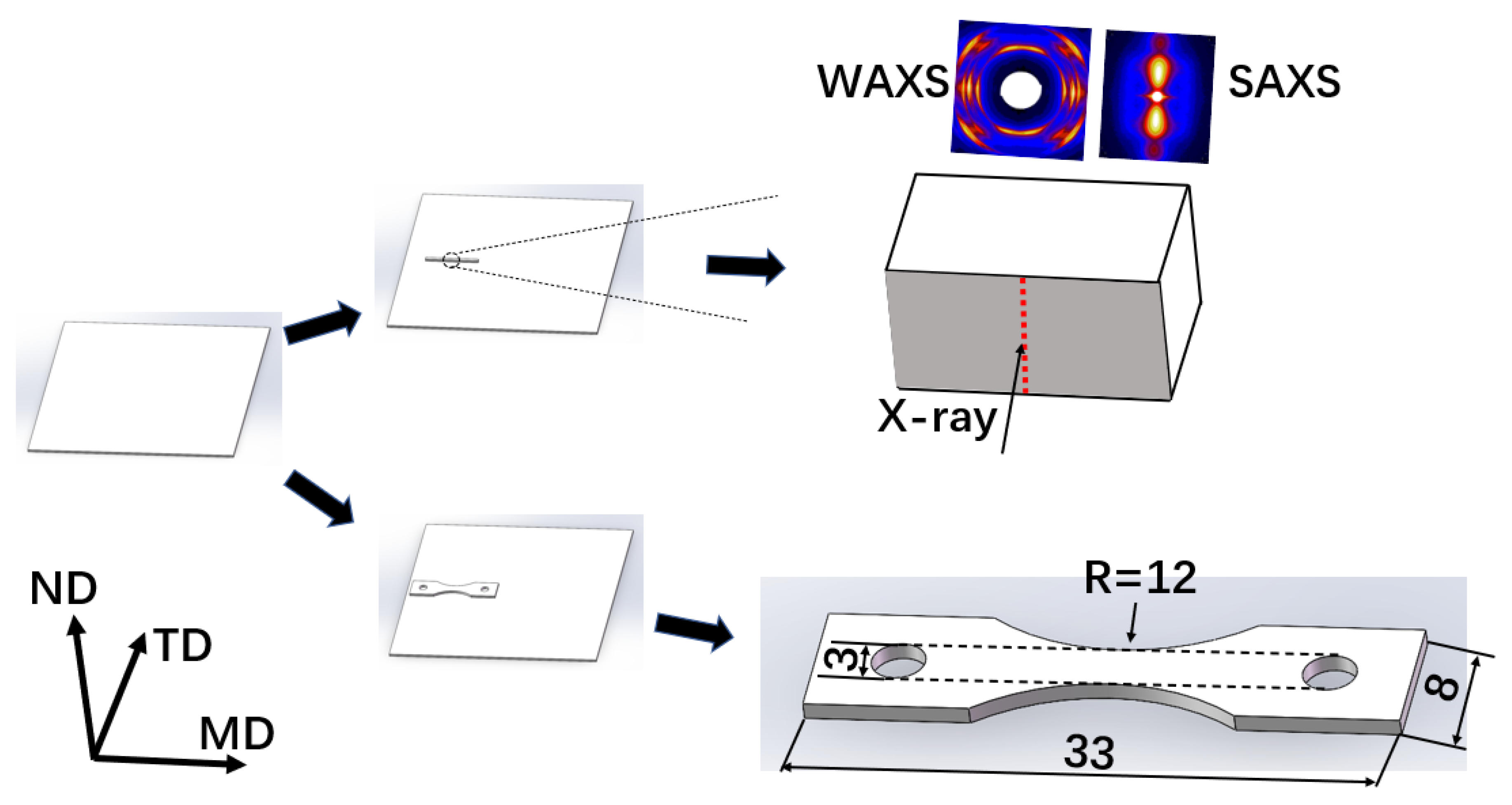
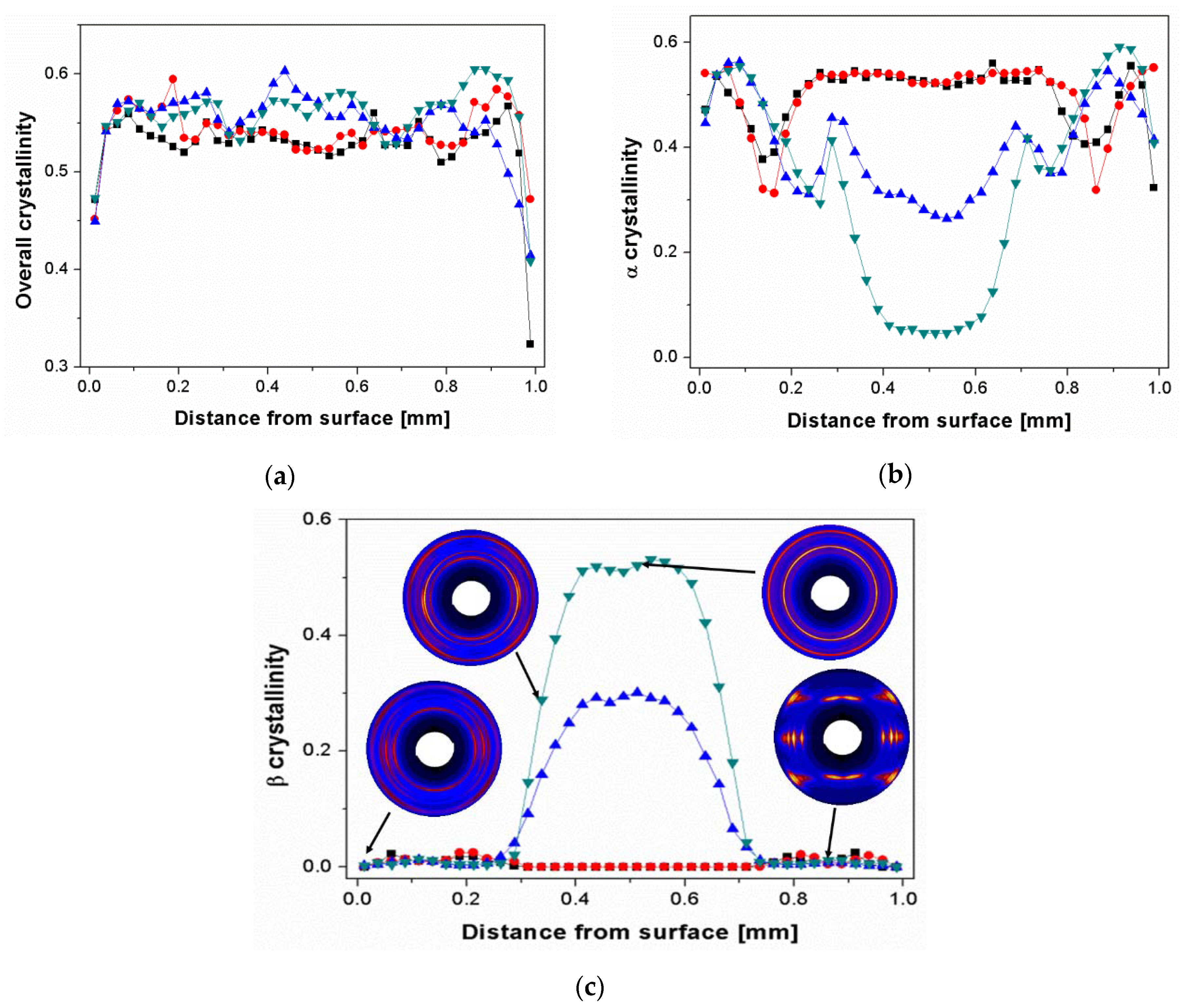
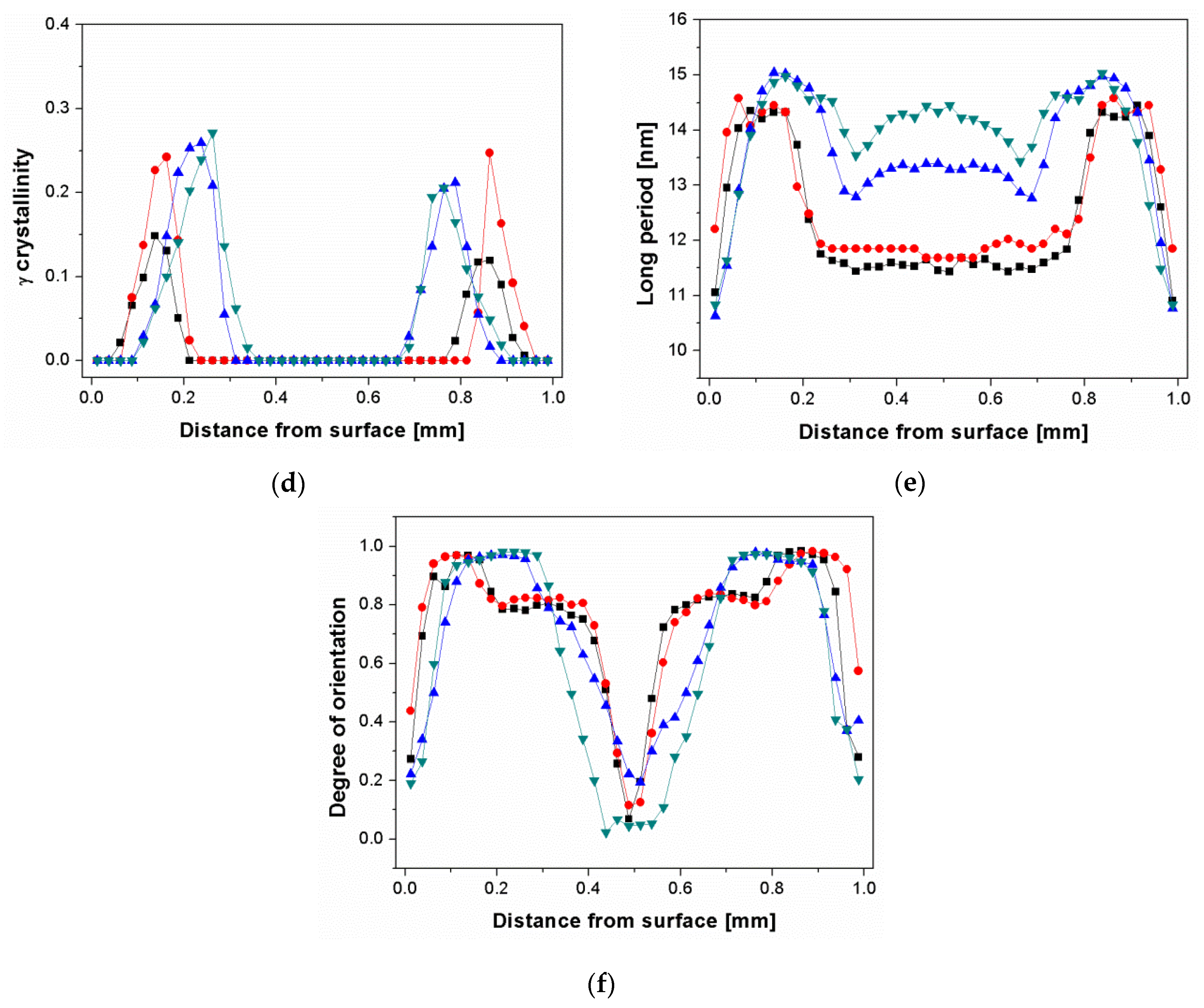
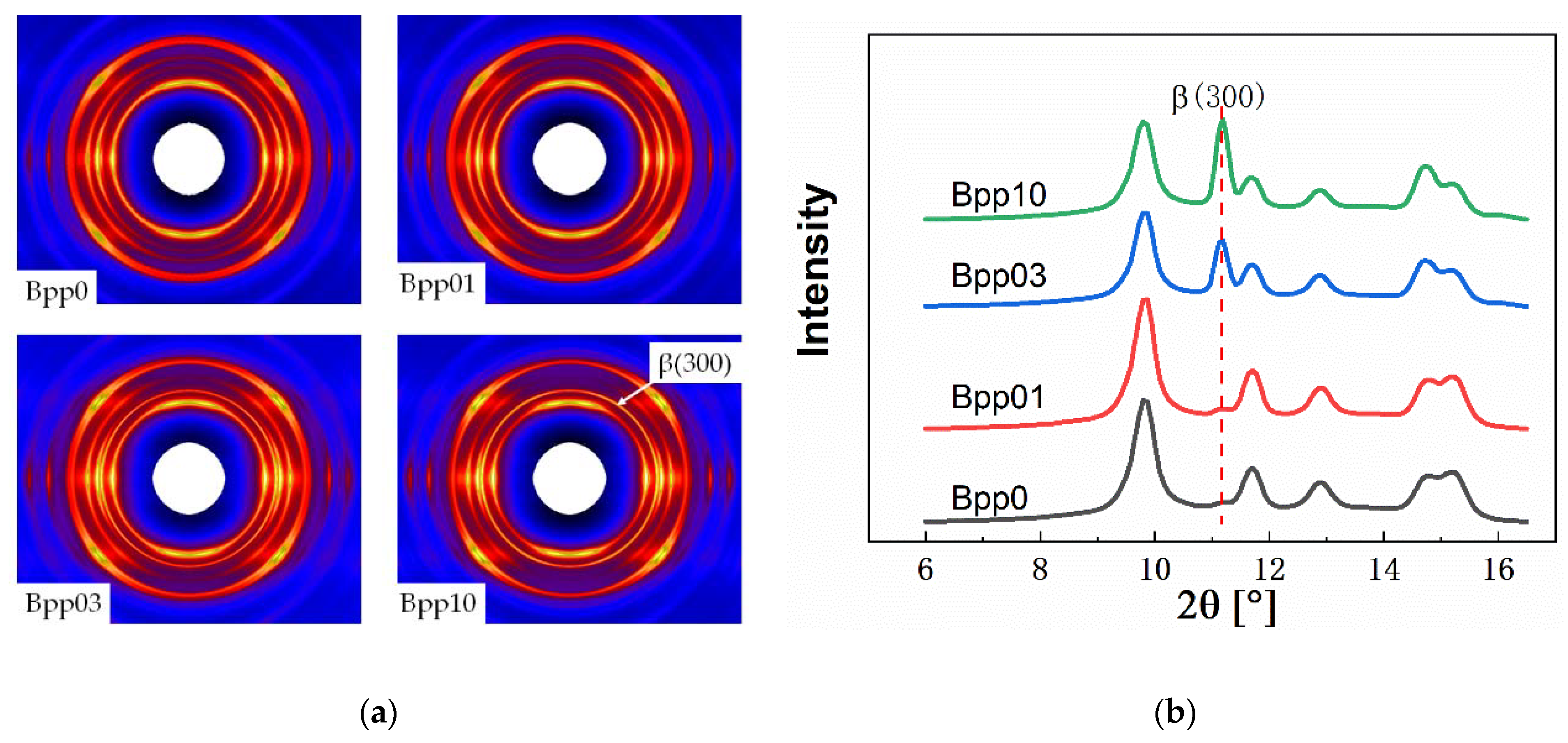

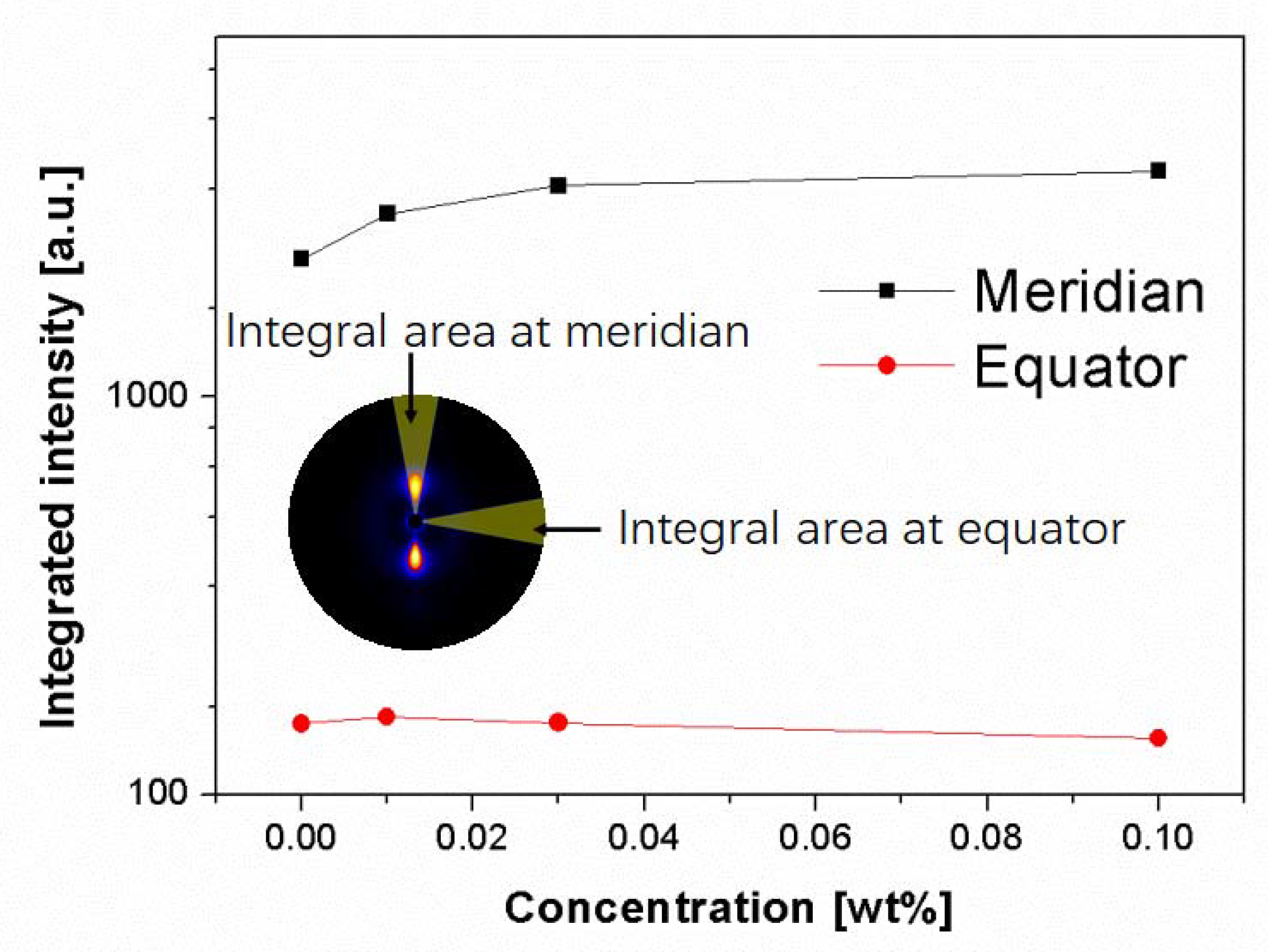
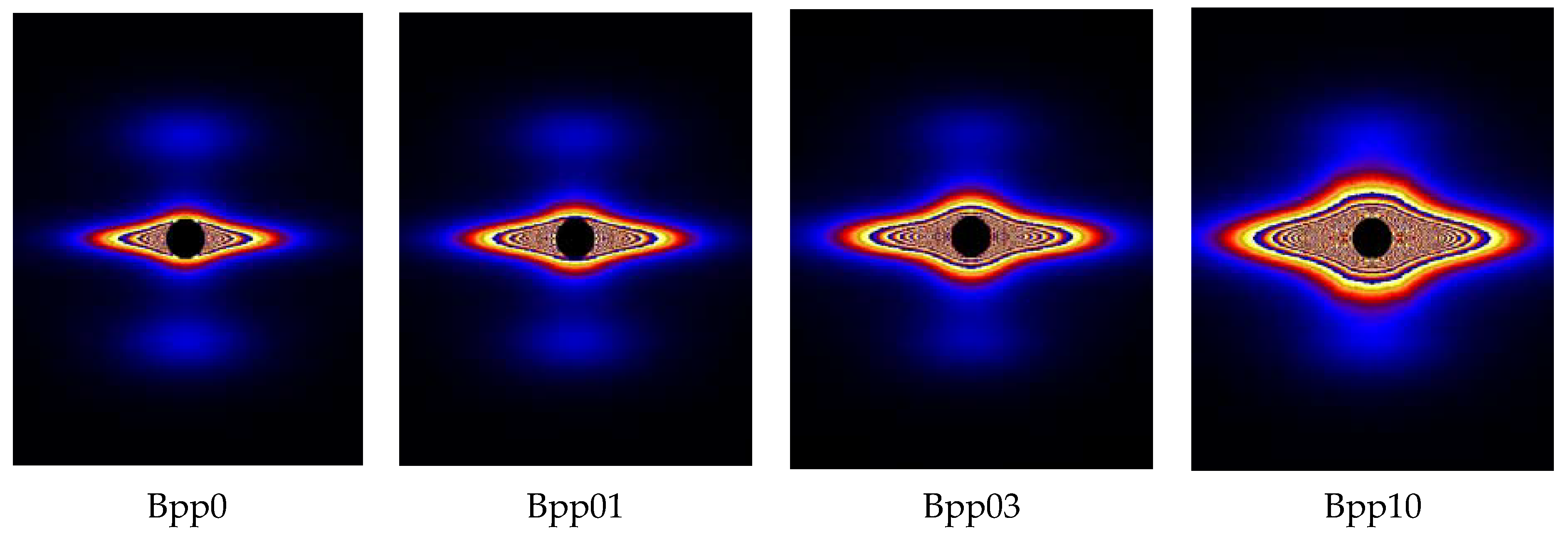
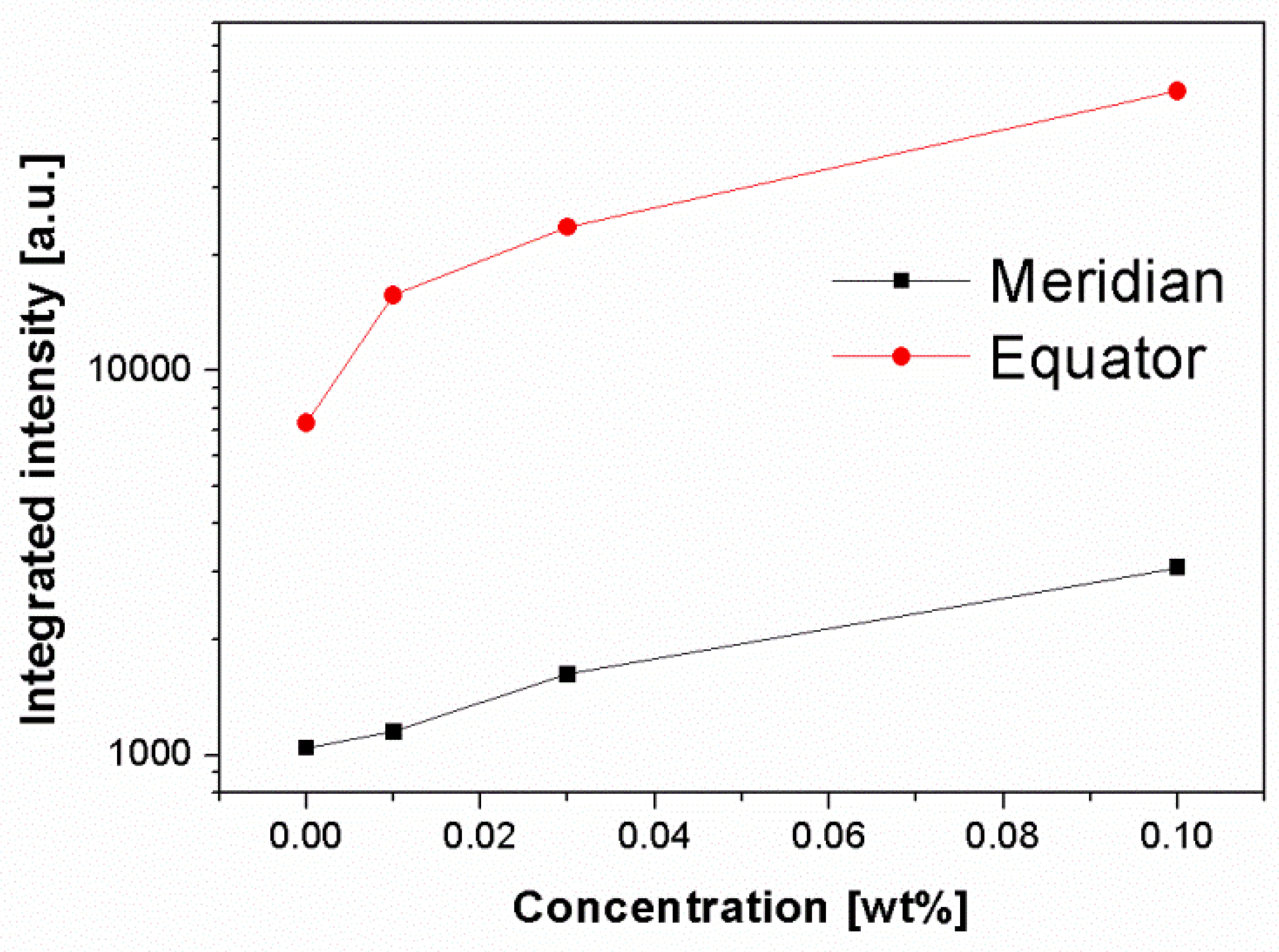


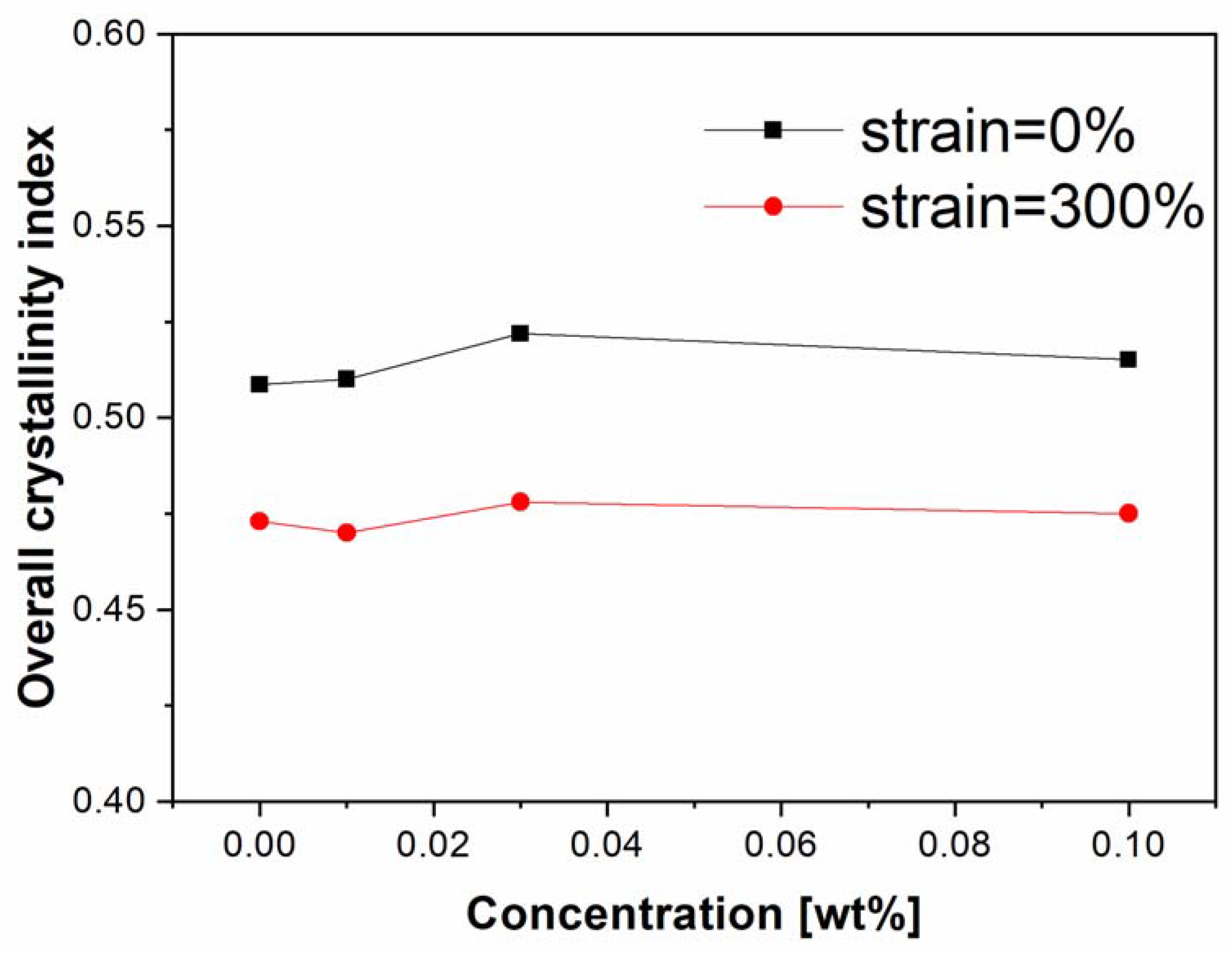
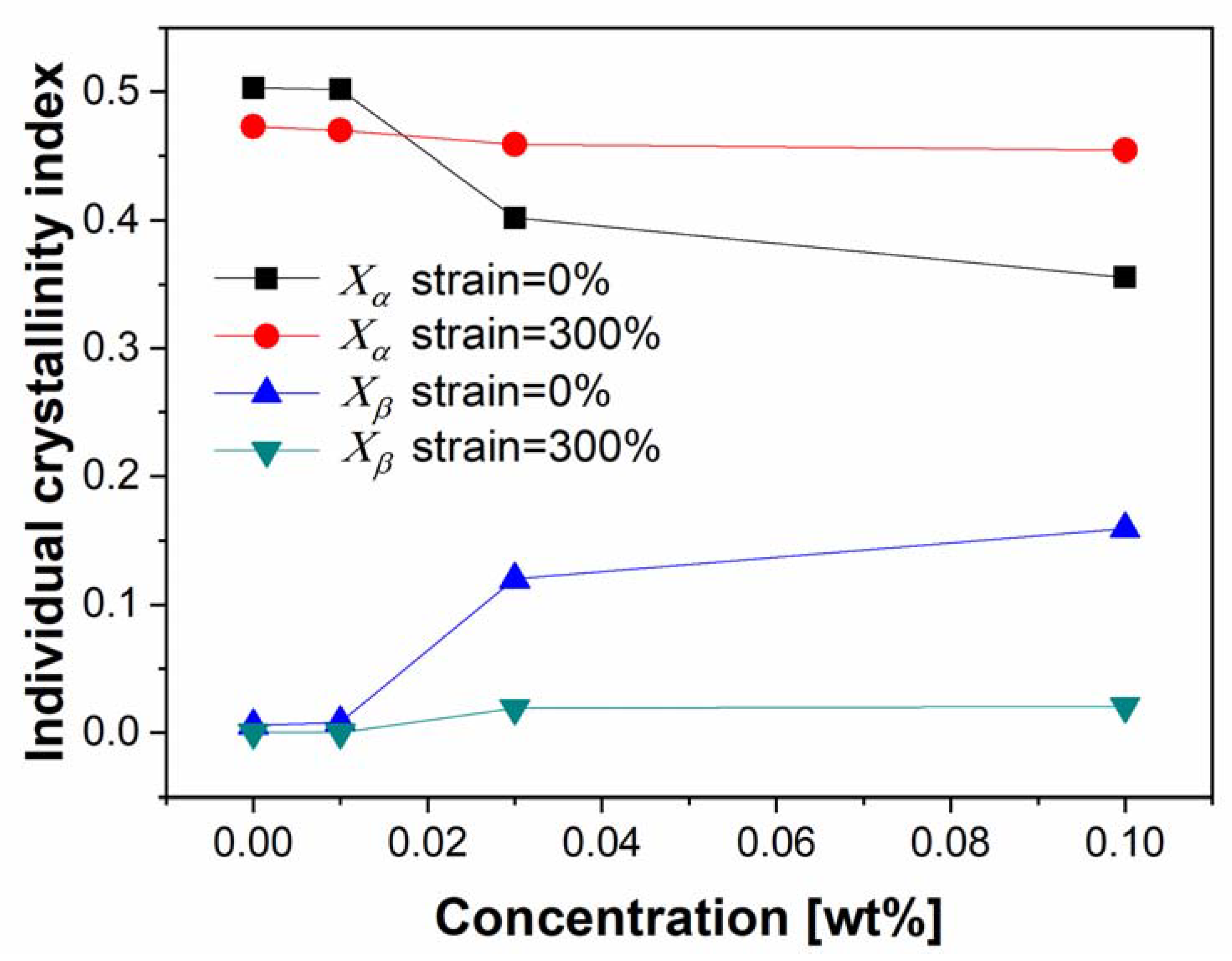

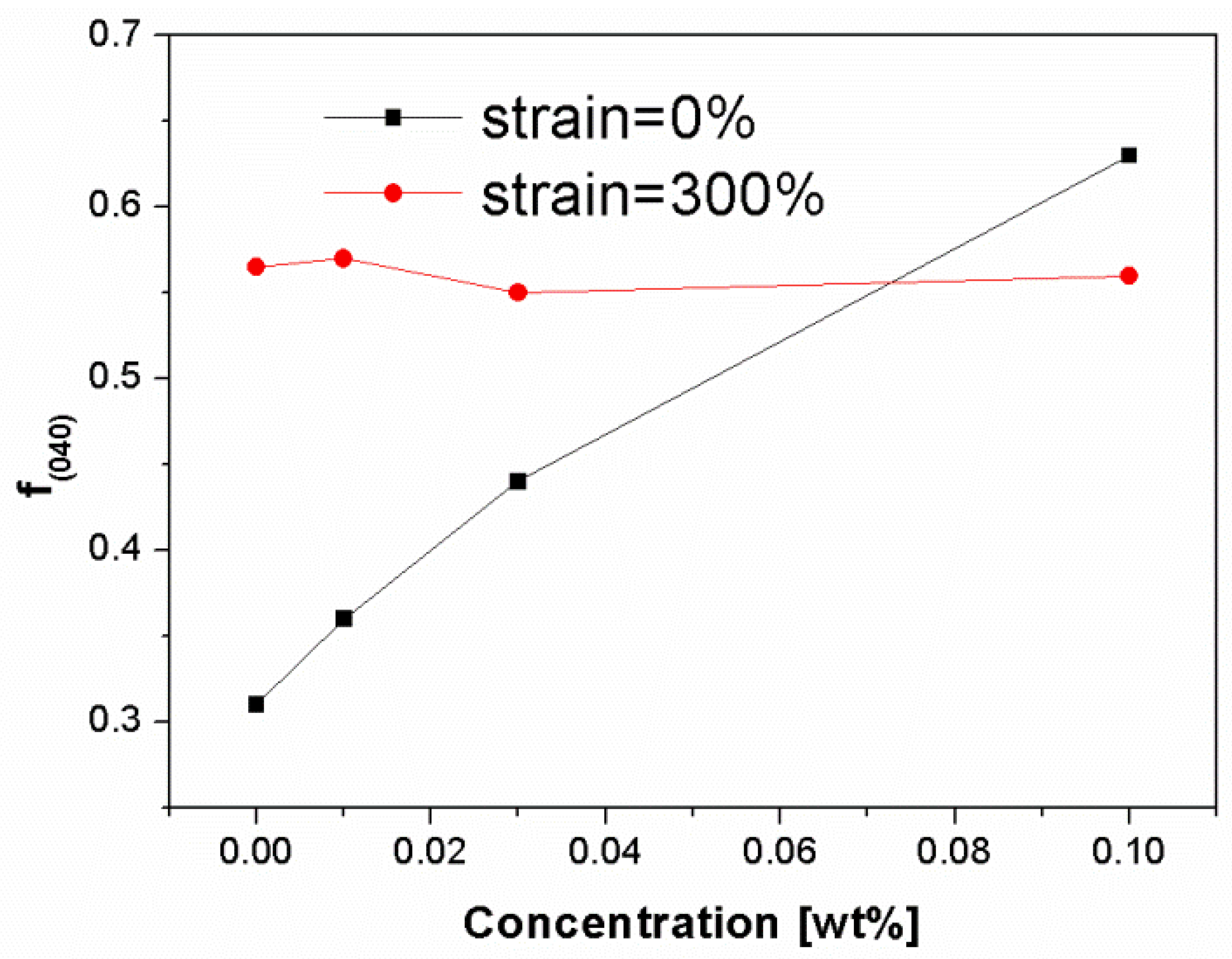
Publisher’s Note: MDPI stays neutral with regard to jurisdictional claims in published maps and institutional affiliations. |
© 2021 by the authors. Licensee MDPI, Basel, Switzerland. This article is an open access article distributed under the terms and conditions of the Creative Commons Attribution (CC BY) license (https://creativecommons.org/licenses/by/4.0/).
Share and Cite
Chen, J.; Schneider, K.; Heinrich, G. In-Situ Synchrotron X-ray Study on the Structure Variation of Morphology-Identified Injection-Molded β-Nucleated iPP under Tensile Deformation. Polymers 2021, 13, 3730. https://doi.org/10.3390/polym13213730
Chen J, Schneider K, Heinrich G. In-Situ Synchrotron X-ray Study on the Structure Variation of Morphology-Identified Injection-Molded β-Nucleated iPP under Tensile Deformation. Polymers. 2021; 13(21):3730. https://doi.org/10.3390/polym13213730
Chicago/Turabian StyleChen, Jianhong, Konrad Schneider, and Gert Heinrich. 2021. "In-Situ Synchrotron X-ray Study on the Structure Variation of Morphology-Identified Injection-Molded β-Nucleated iPP under Tensile Deformation" Polymers 13, no. 21: 3730. https://doi.org/10.3390/polym13213730
APA StyleChen, J., Schneider, K., & Heinrich, G. (2021). In-Situ Synchrotron X-ray Study on the Structure Variation of Morphology-Identified Injection-Molded β-Nucleated iPP under Tensile Deformation. Polymers, 13(21), 3730. https://doi.org/10.3390/polym13213730






